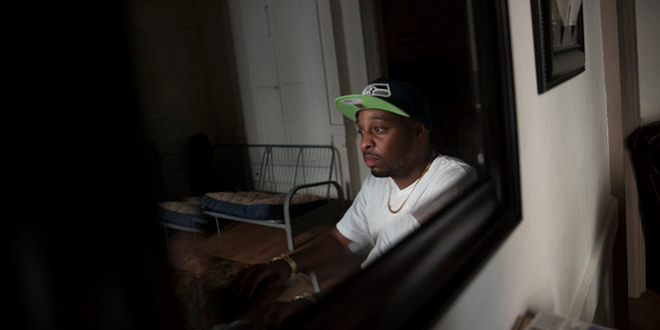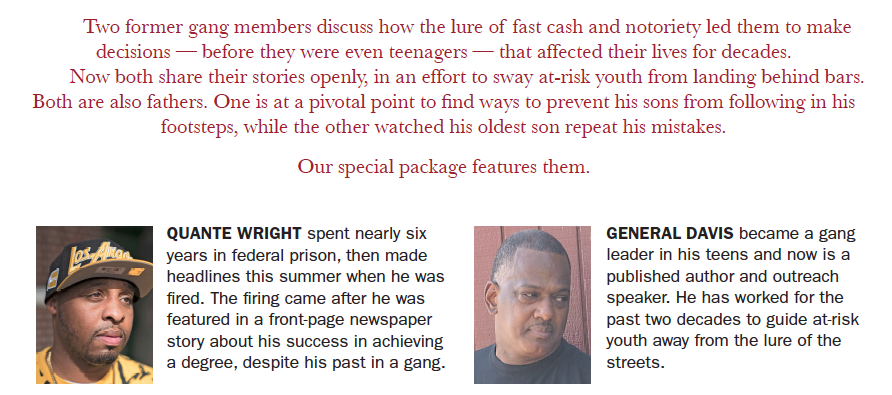What would have kept you from joining a gang?
“Move.”
Quante Wright says it’s the only thing his mom could have done to prevent him from joining Brighton Brigade.
“Move me out of that environment. When I came off my porch,” he said, “all I saw was drug dealers.”
Looking back, Wright notes three catalysts that propelled him into gang life. No. 1: Finding 15 dime bags of crack cocaine at the age of 13. No. 2: The money and prestige that followed. No. 3: Earning his first war wound when a rival gang member stabbed him.
Now at age 30 as a convicted felon, he continues to search for a secure job while wearing an ankle-monitoring bracelet. He’s on parole until 2017. He’s also in debt with credit card bills and school loans, behind on child support and struggling to cover his monthly rent.
HOW IT ALL STARTED

The “pre-gang” activity, as Wright refers to it, began in Clary Middle School.
“We started these cliques,” he said. “The 111, 222 and so on.” The school had four major hallways and each clique controlled a certain one. “You got caught in the wrong hallway, you got jumped,” Wright said, but then quickly interjects, “playfully jumped.”
“It was all play, but if someone would have taken notice, the path I took may have been different.” Wright said.
“Seventh-grade was pre-gang. By eighth-grade, I was repping (representing) Matson ADs” he said, “Matson” in honor of his street address and “AD” meaning adolescents. Though he still considered his clique all play, the nature of the group had elevated from the hallway to the street corner, only a few steps from his front door at the corner of South Salina Street and Matson Avenue.
Recounting his story during his first formal outreach speech given Aug. 1 at the Save Our Sons Empowerment Workshop, Wright shared how he divvied up the 15 dime bags of crack cocaine he found at Cannon Street and West Pleasant Avenue. He said using his good math skills, he quickly figured each bag at $10 apiece equaled $150.
He continued, saying at age 13 drugs were difficult to sell. “I was about my son’s size then,” he said, pointing to the back of the room where one of his two boys sat. Dealers on the street first told him to head home, saying, ‘Boy, you too small.’
But he says he kept dealing over the next five years and turned those dime bags into quarter-ounces, then to ounces and eventually bricks, meaning one full kilogram of pure cocaine.
Wright blames growing up without a father, lack of supervision and a mother who basically condoned his activity.
His sister, who is two years younger, says she eventually figured out he was a drug dealer.
“He got the new Jordans every time a pair came out,” said his sister, Cierra Wright, 28, with a sort of laugh. “That’s when I knew.”
His peers at this time would say: “He getting money,” explained Wright’s close friend, Rick Parks, who was a part of the Matson ADs but never joined a gang. “He was getting attention from females, he had cars, designer clothes. People would say he was a flashy guy,” Parks added.
Wright describes himself in his early teens. “I saw myself as a hustler. I was out making money, trying to look fly. I didn’t yet think of myself as a gang member.”
Then in summer 1999 at the age of 14, he got into an altercation with a rival gang member outside Central Tech Vocational Center and was slashed in the chest with a six-inch folding knife. With eight stitches, he left the hospital and went directly back to the street. After the incident, which involved 15 youths, the school stepped up security by installing metal detectors.
“The stabbing gave me more street cred and more recognition,” he said. “It solidified me as a gang member.”
The incident also made him a target to rival gangs. In preparation, he purchased his first gun to retaliate.
By this point, he says his mom — “really no one” — could have made him leave the gang.
“She didn’t want me selling drugs, but at that age, there wasn’t nothing she could do. My needs — or rather let’s say my wants — became more than she could handle. My sneakers, my clothes — all were more expensive. She didn’t want me to, but there was no way to stop me.”
Created with flickr slideshow.
PREVENTIVE MEASURES
 Wright names a few things that could have prevented his leap into street life: A gang prevention curriculum at school; guest speakers who spoke honestly about the consequences of such a lifestyle; and a staff person who monitored individual behavior, addressing the red flags as they popped up, such as flashing the signs of the clique, gambling and repeated expulsions.
Wright names a few things that could have prevented his leap into street life: A gang prevention curriculum at school; guest speakers who spoke honestly about the consequences of such a lifestyle; and a staff person who monitored individual behavior, addressing the red flags as they popped up, such as flashing the signs of the clique, gambling and repeated expulsions.
“Maybe there were efforts and I was just blind to it,” Wright said about programs or community initiatives at the time.
One effort in place in 1999 — the same year Wright’s gang membership was solidified — was the Syracuse Partnership to Reduce Gun Violence, a federally funded grassroots program with which General Davis worked. Davis was a former gang member from the 1970s doing outreach on the South Side.
That year Wright started 10th grade at Nottingham High School — one of the schools where Davis spoke. But Wright never heard Davis’ anti-gang speech. Instead, after one month at the school, he found himself locked up at Hillbrook Juvenile Detention Center.
This was just the start. Future criminal charges Wright would face included: possession of controlled substances, robbery, burglary, criminal use of a firearm, criminal mischief, reckless endangerment and assault.
SYSTEMATIC FAILINGS
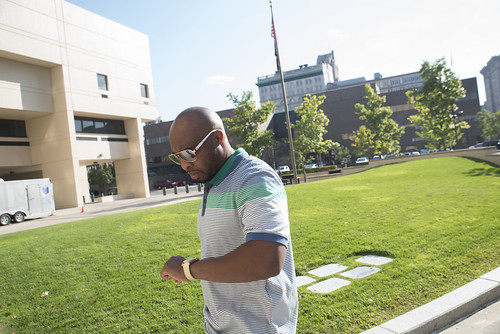
At age 15, Wright was moved from Hillbrook to a group home near Albany for rehabilitation.
The state-licensed LaSalle School states that its mission is to “provide therapeutic, educational and supportive services designed to accomplish positive, personal growth and lasting change in the lives of youth and families in need.”
But Wright feels the center propelled him further into criminal activity. “It made me a smarter criminal,” he said of the experience.
Research indicates that youth who have been placed with the New York State Office of Children and Family Services, which includes LaSalle, have unacceptably high recidivism rates. A 2009 Division of Criminal Justice Services plan reported that by age 28, 89 percent of males and 81 percent of females who had served time in the office’s custody were rearrested.
BEING STUCK
After several run-ins with police and time in and out of jail before he was 19, Wright says he wanted out.
“It was all too much. I was living with so much remorse and regret. I called my father, believing he could be a way out.”
Lying in bed, he remembers making the call to his dad, who was living in the South at the time. Wright asked if he could move down there, and if his father would help him to get on his feet in a new location.
“I asked him, ‘Can I just come down there and you show me the ropes? I don’t need you financially,” Wright recalled. “To my surprise, he told me ‘No.’”
His father said he was busy supporting Wright’s half sister, who had started college.
“I never called you asking for nothing,” Wright said he thought at the time. “It was a knife to my heart.”
With aspirations to stop his criminal behavior but no support, Wright gravitated back to the street. Criminal charges continued to pile up until officers went to his mother’s home in 2006. The officer who escorted a handcuffed Wright outside told him: “Quante Wright this is the RICO and now it’s Brighton Brigade’s turn (to be busted).”
Along with 13 others, Wright faced charges of violating the federal Racketeer Influenced and Corrupt Organizations Act, known as RICO. The indictment listed 82 overt acts —including drug trafficking, attempted murder, robbery and witness tampering — as evidence the young men were acting as a criminal enterprise.
Five days after his daughter was born, Wright was sent to federal prison to serve at USP Big Sandy in eastern Kentucky. The distance made it impossible for his family to visit. He did not see his daughter again, or his two sons, until she was 5 years old.
PAYING FOR HIS MISTAKES
“When the feds locked me up,” Wright said, “I cried in jail.”
Others at the high-security penitentiary asked if he was part of the Cartel or the Bloods or Crips.
He responded: “No. I’m a Christian.”
He vowed to walk with God and no longer run with a gang. In prison, he was baptized, studied the Bible and went on to lead Bible study groups.
After spending nearly one-third of his life behind bars, he had chosen to give up the gang life. During his speech in August at the Save Our Sons Empowerment Workshop, he credited God for helping him to share his story.
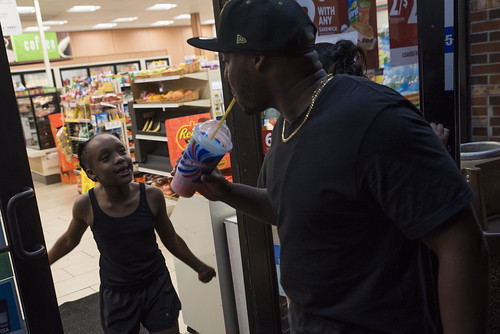
Some 75 men registered for the workshop, which was attended by Syracuse Police Chief Frank Fowler. It was held to raise awareness about issues that affect boys and men, including the role of the black male in the family and how to deal with law enforcement.
Co-organizer Rhea Parks says the event was planned because she “strongly believes it takes a village to raise a child. I have four little boys and while their father and I are together and they have a male in the house, they can only benefit from more role models. I thought Quante’s speech was excellent because he shared a personal experience that could resonate with the youth who attended.”
Hasan Stephens, executive director of A Good Life Foundation, which works with at-risk youth, also participated on the panel.
“I think a strong point Quante made was that he stayed in too long, but I teach that even one day in the streets is too long,” Stephens said. “I think he could have done a better job of making the life sound less enticing.”
Stephens said he strongly feels the goal of these events should be to ensure the consequences of actions are understood.
In the future, Stephens said, “He should stress the time away that he missed from his family being locked up and chances he lost in his education.”
INTERRUPTING THE CYCLE
Now Wright worries about the future of his own sons, who are a month apart — one who turned 13 in September, and the other who will turn 13 this month.
“With everything going on in my life, and the fact that there are different mothers and relationships that I’m no longer involved with, it’s hard. But I know now is the time that I have to pay my kids more attention,” Wright said.
Thinking about his sons’ home life, particularly his older 12-year-old, Wright believes their environments are nothing like his growing up.
And when thinking about teenagers growing up, Wright also thinks about his nephew who looked up to him and was sentenced for manslaughter while Wright was incarcerated. “He had no one to look out for him while I was gone.”
Rick Parks agrees. “[Growing up], we weren’t guided right. There was no structure for us. Basically we were free to do as we wanted. We were able to come in and leave as we pleased. That’s basically where things go left sometimes, when the mother is busy working to support the family and her sons lack structure in the home.”

As a father, Wright knows he is not physically in the household, but says he’s accessible and there any time they need him.
Last school year was one of those times. The Syracuse Academy of Science Charter School called Wright into the office, saying his son was in danger of being expelled because of his performance and behavior.
In cooperation with the school officials, Wright, his son and the administration spoke about the concerns and then signed an agreement that his son would get back on track.
“His behavior and his grades improved,” Wright said.
The experience reminded Wright of his freshman year at Corcoran High School. He was expelled, he says, after the school learned he had been arrested.
“Unlike my son, I was never given a second chance,” he said.
Even with the school’s and his disapproval of emulating thug-like behavior, Wright says he sees that his sons find his former gang life appealing.
Wright’s sister, Cierra, explains: “They grew up hearing about him and in some ways they think that side of him is cool. But Quante teaches them to do better.”
He brought both sons to his speech but has told them little specifics about life after prosecution or the consequences he still faces. He is starting to navigate that path now as he hears, specifically his older son, recite rap lyrics or imitate street slang and emulate that ‘play’ behavior familiar to Wright.
Parks, who has five sons, advises that Wright needs to convey the severity of the consequences that come with being a gang member.
“He needs to have a real sit-down with them, letting them know what he went through, not just say to not act like a gangster,” Parks said. “He needs to tell them the ins and outs of what can happen and what did happen. The deaths he saw, the number of funerals of our friends he’s attended.”
CONTINUED CONSEQUENCES
This year, Wright became a father for the fourth time, completed an associate’s degree, was sentenced to spend two months at a halfway house for a parole violation and shared his story on the cover of the Sunday Post-Standard. That story sparked a week of life-changing events.
The day after publication, he was fired from his dream job as a car salesman at Lowery Bros. Chrysler Jeep. Wright believes he was fired because of details shared in the article. Steve Spector, hiring manager, offered no comment when reached by phone last month.
Then Wright violated parole when he failed to report directly back to the halfway house after being fired. He spent Father’s Day weekend in jail. Working with lawyers, he struck a deal and was enrolled in Intensive Re-Entry Court.
Each month Wright must attend Intensive Re-Entry Court with a team of legal professionals consisting of U.S. Magistrate Judge Andrew Baxter, Assistant U.S. Attorney Tamara Thomson, Assistant Federal Public Defender Randi Bianco and Senior Federal Probation Officer Liana Snyder.
Conditions of his parole include paying the $80 monthly service fee for the ankle bracelet, responding to call-in drug checks, surprise visits by his parole officer and a curfew, which is 9 p.m.
During his August re-entry court hearing, out of seven participants, Wright was called up fifth to hear updates on his progress that month. Before the judge, Snyder reported Wright was seeking employment but hadn’t landed a job, had three missed calls to the drug program and failed to provide a copy of a key to his apartment, which had been court ordered.
Thomson next spoke. “It is clear that you would like a particular job, a particular salary, but you also must be realistic,” she said about his expectations. “It seems like you want to get to your end game by skipping several steps.”
Both Snyder and Thomson encouraged Wright to be practical about job prospects, noting he may have to start off lower and then work his way up the ladder.
Participants in the Intensive Re-Entry Court program are in supervised release from prison; they sign a contract with the legal team agreeing to work to meet the expectations agreed upon each month. If goals are met, the participant receives a “reward” somewhat like a pass/fail. Twelve rewards are needed to complete Phase I. Since the program’s launch in 2010, the team said only one participant has completed Phase I in 12 months.
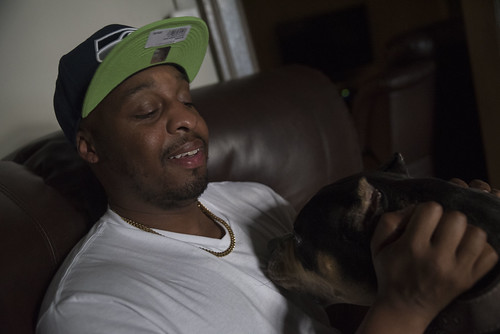
Additional requirements must be met to complete Phase I: the participant must be drug/alcohol free, gainfully employed or enrolled full time in school, have no pending criminal charges and be current on any court-ordered financial obligations, including child support.
In August, Wright did not receive a reward.
Instead the judge told him, “Nobody here wants to stand between a participant and their dreams. We are not trying to discourage you … but … what is the cliché? ‘Don’t give up the good waiting for the perfect.’ If you have the gifts you think you have, once you get your foot in the door, then you’ll be able to move up.”
Wright was given a chance to respond and told the judge of three job interviews he had completed and that he was hopeful something would come through the next week.
Later, sitting at his kitchen table, he says after nearly three years out of prison he is still in a mode to reinvent himself. “I got to figure this out,” he said. “I sit here twiddling my thumbs with no income. I’m not selling drugs no more, so I got to do something.”
After Wright got out of prison, Parks recalled Wright telling him: “I’m going to make an empire out of my situation.”
Since 2012, Wright has tried his hand at various business launches, music and even movie releases and 9 to 5s but yet to find his niche. He feels he is a superstar waiting for his big break.
During his most lucrative weeks selling crack cocaine, he was pulling in nearly $10,000. Since late August, he has been working part time with GMR Marketing making $18 an hour.
“I like nice things and I want financial freedom,” he said. “I don’t want my kids to even think about having to go to the streets. Instead of calling a drug dealer, they should think, ‘I can just call my daddy.’”
— By Ashley Kang, The Stand director
 The Stand
The Stand

